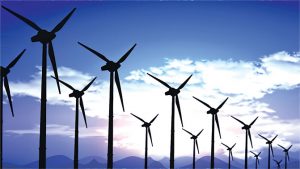World Bank Group: Should Oil Exporters Shift Capital Stock to Renewables?
 As the Financial Times pointed out recently, oil companies such as ExxonMobil and Shell would, under measures considered for the global climate pact to be sealed in Paris next year, cease to exist in their current forms in 35 years. A proposal to phase out global carbon dioxide emissions by as early as 2050 was not resolved during the UN climate talks held in Lima last December.
As the Financial Times pointed out recently, oil companies such as ExxonMobil and Shell would, under measures considered for the global climate pact to be sealed in Paris next year, cease to exist in their current forms in 35 years. A proposal to phase out global carbon dioxide emissions by as early as 2050 was not resolved during the UN climate talks held in Lima last December.
However, the adoption of even a watered-down version of this proposal, in Paris or in later rounds of climate negotiations, would mean that the amount of oil and gas produced by these companies, and the quantity of coal mined by enterprises such as Rio Tinto, would need to be greatly reduced by mid-century. Such long-term concerns might over the next years trump current worries about an oil price slump that could be on the wane as soon as marginal projects and producers are shaken out from the bottom of the market.
Government Oil Revenue to Fall
Whereas ExxonMobil and Shell are private companies, national oil companies such as Saudi Aramco, Statoil, and others control about three-quarters of all crude oil production and more than 90% of reserves. For a radical reduction in global carbon emissions to be achievable, state-owned oil companies would need to dramatically reduce the production of hydrocarbons.
If that should happen, government revenues from hydrocarbons would be a fraction of what they are today. But oil-rich countries have become so dependent on oil exports that a viable economic future is hard to imagine were these exports to be significantly reduced. National oil companies’ production decisions are likely to be less affected than private companies by price mechanisms such as a carbon tax, particularly for those companies that benefit from large low-cost reserves. However, in the long run, carbon pricing and technological developments in the renewables sector are likely to affect even these companies.
Renewable Energy Exports Could Replace Oil
Many of today’s oil and gas exporters are doubly blessed: they are endowed with rich oil, gas and mineral deposits and also exhibit exceptionally good conditions for the generation of renewable energy (high intensities of sunlight or wind, an abundance of land that might be used for solar plants and wind farms, and relative proximity to major energy markets). These conditions provide them with the option of maintaining their traditional sources of energy exports, while developing alternative energy sources.
“Whereas ExxonMobil and Shell are private companies, national oil companies such as Saudi Aramco, Statoil, and others control about three-quarters of all crude oil production and more than 90% of reserves. For a radical reduction in global carbon emissions to be achievable, state-owned oil companies would need to dramatically reduce the production of hydrocarbons.”
Consider Saudi Arabia and other oil-exporting desert nations. The vast deserts of the Arab peninsula could provide enough solar energy to satisfy a significant share of European demand, while leaving capacity to spare for neighbouring regions. Other oil and gas exporters are blessed with windswept coastlines where energy can be captured from wind, waves, and ocean currents, and sold in regional markets. Such exports would likely require large investments in transmission infrastructure and the development of innovative financing models, as well as the deployment of recent and further innovations in energy storage.
Capital and Energy Potential Are Complementary
The idea of exporting solar power to major markets from neighbouring desert regions is not new. Morocco is fast developing its solar energy potential, at first for domestic consumption – to reduce a reliance on fossil-fuel imports that has strained its balance of payments – with ambitions to export power to Europe later. Oil-exporting nations, meanwhile, have been able to use proceeds from oil sales to build up very large capital reserves in the form of foreign assets held in sovereign wealth funds (SWFs).
Globally, SWFs hold assets worth approximately $6.5 trillion, of which about half is held in oil funds – SWFs that are capitalised by proceeds from oil and gas exports. The world’s largest oil fund, Norway’s Government Pension Fund Global (GPFG), holds foreign assets worth $893 billion. The funds of the United Arab Emirates and of Saudi Arabia are not far behind, with assets worth $773 billion and $757 billion, respectively.
Based on capital costs per watt in the range of $2.50 per peak watt for concentrated solar power, the capital cost of plants providing peak power equal to the average consumption of the European Union could be around $1 trillion. (This does not include costs of transmission infrastructure, or transmission losses). Overall costs are also coming down rapidly, and Dubai’s state utility last November accepted a bid for a photovoltaic solar power plant with a cost per kilowatt-hour of less than six cents. This sets a world-wide record low for the cost of solar electricity, significantly below recent records in Brazil and India of around 8–9 cents per kilowatt-hour.
Unlike private investors, whose incentives are stacked in favour of the short term, SWFs are able to consider the home country’s strategic long-term interests. For most equity funds, with managers frequently judged on quarterly performance, the “long-term” rarely goes beyond 3-5 years, the time required to buy a company and then “fix and flip” it, and pressures from shareholders often keep investment horizons below two years. But sovereign funds, given the right mandate, are in a position to provide large amounts of patient capital. They thus provide oil exporters with a potential strategic advantage in adjusting their economies to a low-carbon world, while potentially reducing risk and earning a fully competitive return.
Macroeconomic Feasibility
Traditionally, oil funds have been used to save for future generations, to stabilize the home economy in the face of highly volatile oil and gas prices, and to reduce the risk of large oil revenues generating asset bubbles and exchange rate appreciation. For these reasons, oil funds tend to invest in foreign assets, mainly traded securities. Such funds may, however, find it increasingly attractive to invest in renewable energy, including in their own home economies.
First, preserving capital and earning a competitive return on renewable energy investments will become increasingly achievable as solar and wind technologies continue to improve, and as more penalties are imposed on carbon emissions through carbon taxation and regulation.
Second, many of the components of wind and solar power infrastructure are typical import goods. This makes a “Dutch disease” or upward pressure on the exchange rate, less likely. “Dutch disease” and asset bubbles are generated by excessive spending on goods and services that are not internationally traded, such as construction work and locally produced construction materials. Imports, on the other hand, do not generate domestic price pressures because supply is in most cases highly elastic, and prices are determined by global demand.
The macroeconomic risk of investing in renewable energy at home could thus be manageable, and countries would need to find a balance between the use of imports and the option of developing national manufacturing industries to produce components for the renewables sector.
Investing through Partnerships
Last year, Norway’s GPFG significantly reduced its exposure to coal and tar sands, a decision that resulted from the fund’s long-term risk assessment. Other oil funds are likely to follow suit, but few large institutional investors have yet moved beyond tracking risk to actively divesting from carbon-intensive sectors – although the pressure to do so is increasing.
Further down the road, decisions to increase investments in renewable energy may involve both commercial and strategic objectives. Whereas foreign sovereign funds’ investment is mainly a commercial undertaking, governments are increasingly seeing their domestic sovereign funds as a vehicle for optimizing returns and strategic national investments through equity and project finance. Domestic investment mandates are motivated by several distinct concerns.
A country may find that there are positive externalities to domestic investment, including growth and productivity-enhancing effects which are not fully reflected in their financial returns. For investments in the renewable energy sector, such externalities could include the development of domestic technological capacity to produce intermediate products for wind and solar plants, and generation of employment.
Investing in power transmission infrastructure may foster profitable export markets. Such bulky investments may require a large institutional investor, or direct government investment, to be feasible. The pursuit of first-mover advantage is also relevant. As regional renewable energy markets develop amid rising carbon prices and more efficient wind and solar technology, current oil exporters with well-capitalised SWFs may be able to establish dominant market positions early on.
Governments are then faced with two separate, but related, questions – of allocation and of agency. First, should they allocate more investment to building a stock of fixed capital for renewable energy generation? Second, should these investments be undertaken through the government budget or by the SWF, possibly through a separate subsidiary?
Both are feasible options, and governments could leverage their own capital through public-private partnerships. A SWF, on the other hand, can act as an expert independent investor, with greater flexibility than the government, within its established mandate. The fund may use a variety of risk-sharing mechanisms to make projects bankable, thereby crowding in private and sovereign investors.
What Are the Risks?
An oil-to-renewables strategy of fixed capital investment is not without risk. The primary risk is to the wealth objectives of the SWF – to its ability to preserve and grow its capital, if non-commercial objectives are allowed to prevail over commercial ones. Co-investing with like-minded public or private investors is likely to reduce this risk, by strengthening investment discipline. Additionally, renewable energy investments must be subject to well-defined return objectives and strict corporate governance principles, allowing the fund to operate as an independent specialised investor within its mandate. This would require the fund to develop the requisite sector expwertise to operate a renewables portfolio.
A Strategic Priority?
Some large oil exporters have begun investing significantly in the production of renewable energy, though not yet for export. Saudi Arabia has embarked on an ambitious program of renewable energy production for domestic consumption, and aims to generate 54 gigawatts of renewable power by 2032, most of it solar.
Several national oil companies are already operating in the renewable energy sector, and their technical and managerial skills are likely to be critical for a successful shift away from hydrocarbons. In Saudi Arabia, Saudi Aramco has been tasked with leading the implementation of the kingdom’s renewable energy policy. According to a recent report by consulting firm Wood Mackenzie, technological development in solar energy could be so fast and disruptive over the next decade that traditional energy companies that are unable to adapt would face a tough market.
No oil-exporting country has yet fully started to replace hydrocarbons in its export composition. Over the next decade, however, oil-rich nations may find that investing in their capacity to remain energy exporters in a low-carbon world should be their highest strategic priority.
The views expressed in this article are not necessarily those of the World Bank.The authors are grateful to Otaviano Canuto, Bryan Land, and Marijn Verhoeven for their highly valuable feedback on earlier drafts.
About The Authors
Håvard Halland is a natural resource economist at the World Bank, where he leads research and policy agendas in the fields of resource-backed infrastructure finance, sovereign wealth fund policy, extractive industries revenue management, and public financial management for the extractive industries sector. Prior to joining the World Bank, he was a delegate and program manager for the International Committee of the Red Cross (ICRC) in the Democratic Republic of the Congo and Colombia. He earned a PhD in economics from the University of Cambridge.
Alan Gelb is a senior fellow at the Center for Global Development. He was previously with the World Bank in a number of positions, including director of development policy and chief economist for the Africa region. His research areas include the management of resource-rich economies, African economic development, results-based financing, and the use of digital identification technology for development. He has written a number of books and papers in scholarly journals. He earned a B.Sc. in applied mathematics from the University of Natal and a B.Phil. and D.Phil. from Oxford University.
Silvana Tordo is a Lead Energy Economist Sustainable Energy Department, Oil, Gas and Mining Unit of the World Bank. Her area of focus includes upstream oil and gas sector policies and strategies, legal, regulatory and institutional frameworks, taxation and petroleum contracts, sovereign wealth funds, and local content. Prior to joining the World Bank in 2003 Silvana held various senior management positions in new ventures, negotiations, legal affairs, finance, and mergers and acquisitions. Her experience includes a wide range of business development activities in the oil and gas sector.
You may have an interest in also reading…
Power to the People — But Let’s Make it Clean and Renewable…
CFI.co meets the high-powered management team of Germany’s RENAIO Assets, experts in sustainability Oliver Platsch and Andreas Grassl had “had
PJ O’Rourke: One of the Last of the Gonzo Journalists
A gonzo-style journalist par excellence, PJ O’Rourke will seldom fail to tackle serious societal issues with sarcastic humour and some
eCapital: Scaling Capacity, Expanding Reach, and Redefining SME Finance
With syndicated lending capacity reaching $2.6bn and a growing international footprint, eCapital is reshaping how small and mid-sized enterprises access



















































































